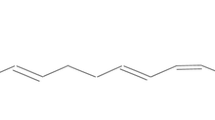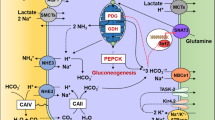Abstract
The urinary excretion of taurine by rats after dosing with various hepatotoxins has been investigated by1H NMR spectroscopy. After single hepatotoxic doses of hydrazine, carbon tetrachloride, 1-naphthylisothiocyanate, or thioacetamide there was biochemical and histopathological evidence of hepatic damage. Proton NMR spectroscopy of the urine collected for 24 h after dosing from these animals revealed a marked elevation in taurine (control 11.9 μmole/h/kg) after dosing with thioacetamide (42.2 μmole/h/kg), carbon tetrachloride (52.5 gmmole/ h/kg), 1-naphthyl-isothiocyanate (80.4 μmole/h/kg) and hydrazine (52.9 μmmole/h/kg). After allyl alcohol administration there was no increase in taurine excretion (7.5 μmol/h/kg). The excretion of taurine after hydrazine administration was dose related. High resolution proton NMR spectroscopic analysis of urine also revealed resonances from several metabolites of hydrazine, an N-acetylcysteine conjugate of allyl alcohol, and acetamide as a metabolite of thioacetamide after dosing with the respective compounds. Changes in endogenous substances that may be related to the pathological events were also detected, such as a decrease in the excretion of 2-oxoglutarate and citrate after both hydrazine and carbon tetrachloride administration. The results confirm that proton NMR spectroscopic analysis of urine is a powerful analytical tool for the evaluation and study of toxic substances. Furthermore, measurement of urinary taurine may provide a non-invasive indicator of acute hepatic damage with certain classes of hepatotoxins.
Similar content being viewed by others
References
Bales JR, Higham DP, Howe I, Nicholson JK, Sadler PJ (1984) Use of high resolution proton nuclear magnetic resonance spectroscopy for rapid multicomponent analysis of urine. Clin Chem 30: 426–432
Chesney RW, Jax DK, Scriver CR, Mohyuddin F (1978) Taurine transport in mammalian kidney. In: Barbeau A, Huxtable RJ (eds) Taurine and neurological disorders. Raven Press, NewYork, pp 73–93
Chesney WR (1985) Taurine: its biological role and clinical implications. Adv Pediatr 32: 1–42
Dent CE, Walshe JM (1954) Amino acid metabolism. Br Med Bull 10: 247–250
Dorvil NP, Yousef IM, Tuchweber B, Roy CC (1983) Taurine prevents cholestasis induced by lithocholic acid sulphate in guinea pigs. Am J Clin Nutr 37: 221–232
Henson PD, Dudley SL, Britton PS, Banks WL (1976) Evidence of enhancement of hepatic pyrimidine catabolism following hydrazine or INH treatment to rats. Proc 67th Ann. Meeting Am Assoc Cancer Res 17: 144
Huxtable RJ, Bressler R (1973) Effect of taurine on a muscle intracellular membrane. Biochem Biophys Acta 323: 573–583
Jacobsen JC, Smith LH (1968) Biochemistry and physiology of taurine and taurine derivatives. Physiol Rev 48: 424–511
Nardi GL (1954) Essential and non-essential amino acids in the urine of severly burned patients. J Clin Invest 33: 847–854
Nicholson JK, Wilson ID (1987) High resolution nuclear magnetic resonance spectroscopy of biological samples as an aid to drug development. Prog Drug Res 31: 427–473
Nicholson JK, Timbrell JA, Sadler PJ (1985) Mercury nephrotoxicity and the detection of abnormal urinary metabolite excretion patterns by high resolution proton nuclear magnetic resonance spectroscopy. Mol Pharmacol 27: 644–651
Nicholson JK, Higham DP, Timbrell JA, Sadler PJ (1989) Quantitative high resolution1H-NMR urinalysis studies on the biochemical effects of cadmium in the rat. Mol Pharmacol (in press)
Reitman S, Frankell S (1957) A colorimetric method for the determination of serum glutamic oxaloacetic acid and glutamic pyruvate transaminases. Am J Clin Pathol 28: 56–63
Timbrell JA, Scales MDC, Streeter AJ (1982) Studies on hydrazine hepatotoxicity 2. Biochemical findings. J Toxicol Environ Health 10: 955–968
Turner FP, Brum VC (1964) The urinary excretion of free taurine in acute and chronic disease, following surgical trauma, and in patients with acute alcoholism. J Surg Res 4(9): 423–427
Walshe JM (1953) Disturbances of amino acid metabolism following liver injury. A study by means of paper chromatography. Q J Med New Series 22: 483–489
Wright CE, Tallan HH, Lin YY, Gaull GE (1986) Taurine: biological update. Ann Rev Biochem 55: 427–453
Yoshida M, Hara I (1985) Composition of urinary metabolites and variation of urinary taurine levels in rats injected with chlorobenzene. Ind Health 23: 239–243
Author information
Authors and Affiliations
Rights and permissions
About this article
Cite this article
Sanins, S.M., Nicholson, J.K., Elcombe, C. et al. Hepatotoxin-induced hypertaurinuria: a proton NMR study. Arch Toxicol 64, 407–411 (1990). https://doi.org/10.1007/BF01973464
Received:
Revised:
Accepted:
Issue Date:
DOI: https://doi.org/10.1007/BF01973464




